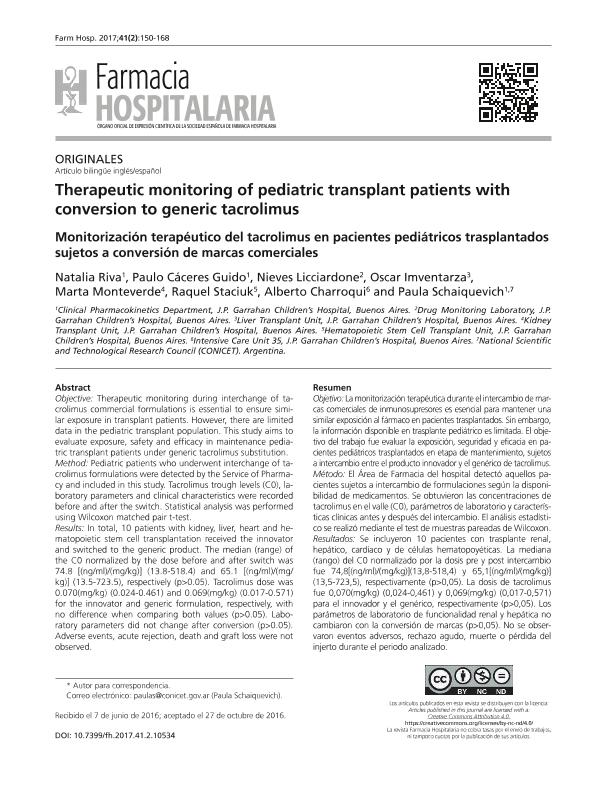Artículo
Objective: Therapeutic monitoring during interchange of tacrolimus commercial formulations is essential to ensure similar exposure in transplant patients. However, there are limited data in the pediatric transplant population. This study aims to evaluate exposure, safety and efficacy in maintenance pediatric transplant patients under generic tacrolimus substitution. Method: Pediatric patients who underwent interchange of tacrolimus formulations were detected by the Service of Pharmacy and included in this study. Tacrolimus trough levels (C0), laboratory parameters and clinical characteristics were recorded before and after the switch. Statistical analysis was performed using Wilcoxon matched pair t-test. Results: In total, 10 patients with kidney, liver, heart and hematopoietic stem cell transplantation received the innovator and switched to the generic product. The median (range) of the C0 normalized by the dose before and after switch was 74.8 [(ng/ml)/(mg/kg)] (13.8-518.4) and 65.1 [(ng/ml)/(mg/kg)] (13.5-723.5), respectively (p>0.05). Tacrolimus dose was 0.070(mg/kg) (0.024-0.461) and 0.069(mg/kg) (0.017-0.571) for the innovator and generic formulation, respectively, with no difference when comparing both values (p>0.05). Laboratory parameters did not change after conversion (p>0.05). Adverse events, acute rejection, death and graft loss were not observed. Conclusion: In our study population, no significant differences in terms of laboratory parameters, drug exposure and dose were observed. We emphasize the need of close monitoring to ensure a safe interchange, especially in vulnerable populations such as the pediatric. Objetivo: La monitorización terapéutica durante el intercambio de marcas comerciales de inmunosupresores es esencial para mantener una similar exposición al fármaco en pacientes trasplantados. Sin embargo, la información disponible en trasplante pediátrico es limitada. El objetivo del trabajo fue evaluar la exposición, seguridad y eficacia en pacientes pediátricos trasplantados en etapa de mantenimiento, sujetos a intercambio entre el producto innovador y el genérico de tacrolimus. Método: El Área de Farmacia del hospital detectó aquellos pacientes sujetos a intercambio de formulaciones según la disponibilidad de medicamentos. Se obtuvieron las concentraciones de tacrolimus en el valle (C0), parámetros de laboratorio y características clínicas antes y después del intercambio. El análisis estadístico se realizó mediante el test de muestras pareadas de Wilcoxon. Resultados: Se incluyeron 10 pacientes con trasplante renal, hepático, cardíaco y de células hematopoyéticas. La mediana (rango) del C0 normalizado por la dosis pre y post intercambio fue 74,8[(ng/ml)/(mg/kg)](13,8-518,4) y 65,1[(ng/ml)/(mg/kg)] (13,5-723,5), respectivamente (p>0,05). La dosis de tacrolimus fue 0,070(mg/kg) (0,024-0,461) y 0,069(mg/kg) (0,017-0,571) para el innovador y el genérico, respectivamente (p>0,05). Los parámetros de laboratorio de funcionalidad renal y hepática no cambiaron con la conversión de marcas (p>0,05). No se observaron eventos adversos, rechazo agudo, muerte o pérdida del injerto durante el periodo analizado.
Therapeutic monitoring of pediatric transplant patients with conversion to generic tacrolimus
Título:
Monitorización terapéutico del tacrolimus en pacientes pediátricos trasplantados sujetos a conversión de marcas comerciales
Riva, Natalia ; Caceres Guido, Paulo Arturo; Licciardone, Nieves; Imventarza, Oscar; Monteverde, Marta; Staciuk, Raquel; Charroqui, Alberto; Schaiquevich, Paula Susana
; Caceres Guido, Paulo Arturo; Licciardone, Nieves; Imventarza, Oscar; Monteverde, Marta; Staciuk, Raquel; Charroqui, Alberto; Schaiquevich, Paula Susana
 ; Caceres Guido, Paulo Arturo; Licciardone, Nieves; Imventarza, Oscar; Monteverde, Marta; Staciuk, Raquel; Charroqui, Alberto; Schaiquevich, Paula Susana
; Caceres Guido, Paulo Arturo; Licciardone, Nieves; Imventarza, Oscar; Monteverde, Marta; Staciuk, Raquel; Charroqui, Alberto; Schaiquevich, Paula Susana
Fecha de publicación:
03/2017
Editorial:
Sociedad Espanola de Farmacia Hospitalaria
Revista:
Farmacia Hospitalaria
ISSN:
1130-6343
e-ISSN:
2171-8695
Idioma:
Inglés
Tipo de recurso:
Artículo publicado
Clasificación temática:
Resumen
Archivos asociados
Licencia
Identificadores
Colecciones
Articulos(SEDE CENTRAL)
Articulos de SEDE CENTRAL
Articulos de SEDE CENTRAL
Citación
Riva, Natalia; Caceres Guido, Paulo Arturo; Licciardone, Nieves; Imventarza, Oscar; Monteverde, Marta; et al.; Therapeutic monitoring of pediatric transplant patients with conversion to generic tacrolimus; Sociedad Espanola de Farmacia Hospitalaria; Farmacia Hospitalaria; 41; 2; 3-2017; 150-168
Compartir
Altmétricas



